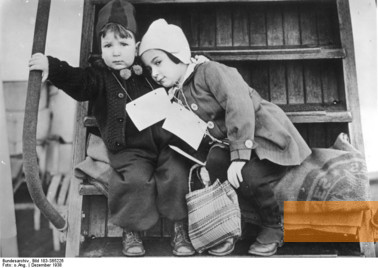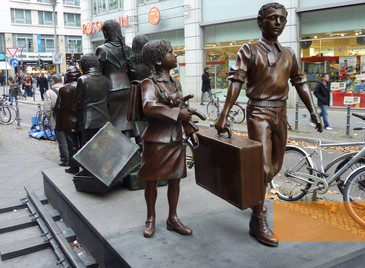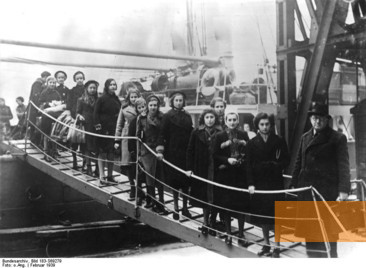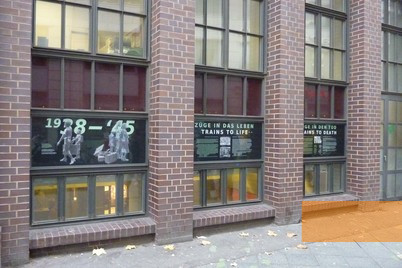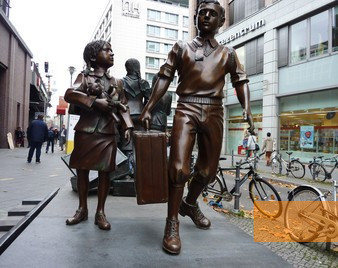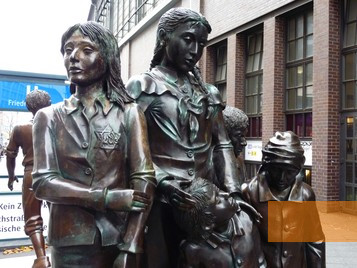The sculpture »Züge in das Leben – Züge in den Tod« (English: »Trains to Life – Trains to Death«) was erected in 2008 on one of the most central places in Berlin. The memorial on the forecourt of the Friedrichstraße station remembers the approximately 10,000 Jewish children who could flee from the German Reich to Great Britain between 1938 and 1939 by help of the »Kindertransporte« (»Refugee Children's Movement«).
Following their rise to power in 1933, National Socialists the started to systematically exclude Jews from society and to disenfranchise them. Jewish businesses were boycotted, discriminating laws excluded Jews from public offices and from marriage to non-Jews. Initially most of the well integrated German Jews decided to stay in their home country. The National Socialists tried to enforce Jewish emigration from Germany by their discriminatory politics, at the same time bureaucratic barriers and the enforced payments of large sums of money made it impossible for many Jews to leave the country. In November 1938 National Socialists set fire to Jewish businesses and synagogues all over Germany, Jews were attacked and assaulted. The Gestapo arrested thousands of Jewish men and held them captive at the Dachau concentration camp for a couple of weeks. From this time on Jewish children were excluded from attending state-run schools. Because of the scale of the pogroms, Jewish relief organisations could obtain – especially for Great Britain – an easing of restrictions on admission for Jewish refugees, particularly for children and youths. From November 1938 to September 1939 Jewish Agencies managed to bring approximately 10,000 children to Great Britain. Their parents were to follow later to emigrate with them to other countries.
By means of the Kindertransporte approximately 10,000 Jewish children could be saved from the German Reich, including Vienna and Prague. After their arrival in Great Britain the children were placed in foster homes or reception camps. At the start of World War II it became almost impossible for the Jewish children to contact their parents in Germany. About nine of ten children never saw their parents again. For many their life-saving escape became a traumatic experience of isolation and separation.
In November 2008 the memorial »Züge in das Leben – Züge in den Tod« (»Trains to Life – Trains to Death«) was ceremoniously dedicated in the presence of many survivors from the Kindertransporte on the forecourt of Friedrichstraße station in the heart of Berlin. The memorial, which was financed by private donations, had been launched by a private initiative several years before. A dispute with the Berlin Senate Administration about the design and a suitable location prevented the implementation. In 2008 the competent borough authorities pledged their support. The memorial was to be erected at the Friedrichstraße station, although the Kindertransporte actually departed from the Anhalter Bahnhof station, now derelict. The memorial was designed by the Israeli artist Frank Meisler, who fled Danzig on a Kindertransport himself. The bronze sculpture is composed of seven figures of children. Two children, made of bright shiny bronze, are walking towards the safety of exile. Turned away on the eastern side of the memorial, five children made of dark tarnished bronze are waiting for the deportation train. On their coats they wear yellow stars. Meisler erected similar memorials along the route of the Kindertransporte: In his hometown Gdańsk, in the Hook of Holland harbour and at the Liverpool Street Station in London.
- Name
- Züge ins Leben - Züge in den Tod
- Address
-
Friedrichstraße station / Georgenstraße
10117 Berlin - Web
- https://kindertransporte-1938-39.eu/
- Open
- The memorial is accessible at all times.


